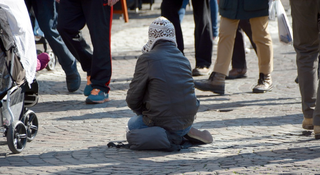Bystander Effect
New Study Suggests Bystander Apathy Is Not the Norm
Cross-national CCTV data reveal bystanders help in 9 out of 10 public conflicts.
Posted July 15, 2019 Reviewed by Davia Sills
A new study using closed-circuit television (CCTV) footage from cities in multiple countries has found that bystanders in large numbers may be much more helpful in emergency situations than we thought. The notion of safety in numbers may be making a comeback.
This story began in 1964 when Kitty Genovese was murdered in New York City in front of 30+ witnesses who reportedly did nothing to help. This real-life incident led to dozens of studies showing that the more bystanders there are, the more the situation will inhibit helping behavior.
This effect has been called “bystander apathy” or the “bystander effect.” Authors of a prominent 1981 meta-analysis summarized over 50 relevant studies and declared that this effect had “withstood the tests of time and replication” (Latané & Nida, 1981).

So the notion of safety in numbers turned out to be a myth, one of the “50 great myths of popular psychology” according to the book by that name (Lilienfeld, 2010). If you are ever a victim who needs help in public, you’d better hope there are not that many passersby.
But in 2007, the truth about Kitty Genovese started appearing in academic journals, namely that some bystanders did intervene by scaring the perpetrator away or phoning the police (Manning et al., 2007).
And in 2008, the truth about the 1981 meta-analysis came out: There was a mistake in the calculations. A reanalysis showed that the more bystanders there were, the more likely a victim would receive help, at least when the bystanders could not all see each other (like in the Genovese case) (Stalder, 2008).
New Study
Now—in a 2019 study titled “Would I Be Helped?”—Richard Philpot and colleagues have compiled a wealth of CCTV footage from urban locations in multiple countries and shown that in 9 out of 10 real-life incidents, at least one bystander did indeed do something to help. Moreover, the more bystanders there were, the more likely at least one bystander would help.
This large-scale, naturalistic investigation raises serious doubts that bystander apathy is the norm (Philpot et al., 2019).
The cities sampled were Amsterdam (Netherlands), Cape Town (South Africa), and Lancaster (United Kingdom). The cameras surveyed “inner entertainment areas and central business districts,” specifically locations like shopfronts, parks, and plazas.
The researchers began with 1,225 clips of “public space aggression that contained any level of conflict—from the mildest animated disagreements to grave physical violence.”
Based on several criteria, the researchers reduced the sample to 219 clips. Criteria included that there were initially no police or paramedics, that there was no other serious incident, such as robbery or drug dealing, and that the clip had sufficient technical quality for behavioral coding.
To count as helping behavior, the bystander had to “act toward the perpetrator or victim in a manner that may soothe the conflict.” Helping acts included “pacifying gesturing,” “calming touches,” “blocking contact between conflict parties,” “holding, pushing or pulling an aggressor away from the conflict,” and “consoling” or “providing practical help” to a victim.
The average conflict lasted a little over 3 minutes with about 16 bystanders, though there was great variability in these numbers across all the clips. The crucial findings were that at least one bystander helped in 90.9 percent of cases and that the more bystanders present, the substantially more likely at least one would help. The three cities did not significantly differ in the degree of helping.
The researchers concluded that “in contrast to the notion that noninvolvement is the norm in urban environments, the high levels of intervention found in this study across different national and urban contexts suggest that involvement [sic] is the norm in real-life inner-city public conflicts.”
The researchers correctly noted that their results answered the question, “Would I be helped?” but not the question of whether more bystanders make it harder to help. In other words, while a victim is more likely to receive help (from at least one person) with a greater number of bystanders, it could be true at the same time that each bystander individually felt greater inhibition to help.
Technically, the “bystander effect” refers to the latter inhibition, but many texts and popular press authors blur this distinction. As a result, the common understanding of the bystander effect seems to be that the victim is less likely to receive help with more bystanders, which the new study clearly contradicts.
Limitations
The researchers acknowledged limitations, including that maybe their definition of helping was too broad, that they only studied inner-city locations, and that their design was correlational (precluding cause-effect conclusions). It was also unclear if the clips included any emergency health situations like those commonly studied before, such as seizures, crashes, faints, or falls (Latané & Nida, 1981).
For some of the limitations, the authors provided counterpoints, like how the absence of sound in the videos precluded counting cases in which a bystander intervened just verbally. So maybe a broad definition of helping inflated the helping rate, but the absence of sound may have led to an undercount.
Implications
In recent history, the notion of safety in numbers was conventional wisdom, then it was a myth, and now maybe it should be believed again at least in this context of public conflicts. High-profile news stories in which no bystander helps are real (not counting the Genovese case), but they appear to be the exception.

In general, vivid or scary stories (compared to large-scale studies) carry too much weight in the average person’s perception. The news media and certain politicians may overreport certain incidents or certain types of people engaging in them, leading to unjustified stereotypes and fears. Steven Pinker thus wrote that “heavy news-watchers can become miscalibrated” due in part to the availability heuristic (Pinker, 2018). More specifically, we may need to abandon certain parts of the negative stereotype of big-city life.
Don’t get me wrong. If you find yourself in a crowd and in dire need of immediate help, it’s still good to follow the textbook advice, like directly pointing at one bystander to ask for help if you can. In a large enough crowd, bystanders can feel greater inhibition to help on their own, due to processes like diffusion of responsibility and pluralistic ignorance.
But according to the new research, we have less to worry about in this situation than we thought. This relative inhibition is usually overtaken by the power of numbers. The more bystanders there are, the more likely we’ll receive help from somebody.
References
Bibb Latané and Steve Nida, “Ten Years of Research on Group Size and Helping,” Psychological Bulletin 89 (1981): 308–24.
Scott O. Lilienfeld et al., 50 Great Myths of Popular Psychology: Shattering Widespread Misconceptions about Human Behavior (Chichester, UK: Wiley-Blackwell, 2010).
Rachel Manning et al., “The Kitty Genovese Murder and the Social Psychology of Helping: The Parable of the 38 Witnesses,” American Psychologist 62 (2007): 555–62.
Richard Philpot et al., “Would I Be Helped? Cross-National CCTV Footage Shows That Intervention Is the Norm in Public Conflicts,” American Psychologist (June 3, 2019), advance online publication, https://psycnet.apa.org/doiLanding?doi=10.1037%2Famp0000469.
Steven Pinker, “The Media Exaggerates Negative News: This Distortion Has Consequences,” Guardian, February 17, 2018, https://www.theguardian.com/commentisfree/2018/feb/17/steven-pinker-med….
Daniel R. Stalder, “Revisiting the Issue of Safety in Numbers: The Likelihood of Receiving Help from a Group,” Social Influence 3 (2008): 24–33, https://www.tandfonline.com/doi/abs/10.1080/15534510701766181.




